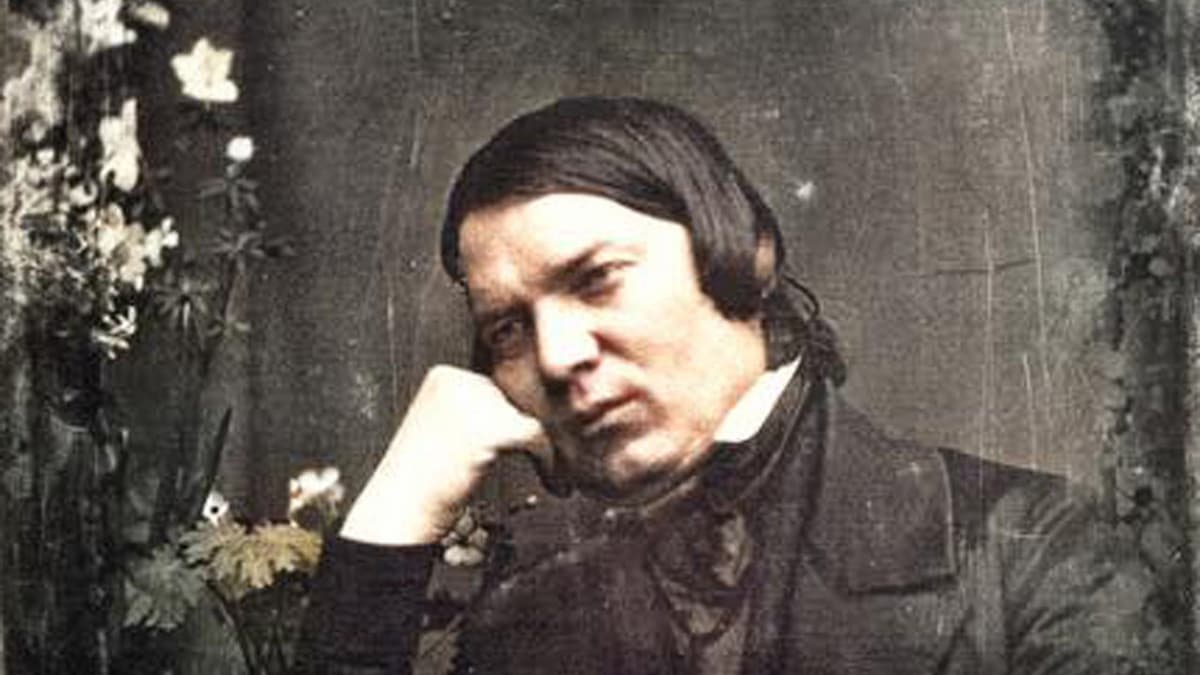In April 2023, PBS’s long-running television series Great Performances released a new documentary called “Schumann: Genius and Madness.”

Robert Schumann, 1850 © pianolit.com
This documentary is part of the miniseries Now Hear This, hosted by violinist and conductor Scott Yoo. Each episode features performances by Yoo and his musician friends as he learns more about the great composers.
Schumann is one of the most interesting composers in classical music history, and this documentary was thought-provoking. I knew as soon as I watched it that I wanted to share what I thought. Maybe you’ll want to check it out yourself.
Official Preview | Now Hear This “Schumann: Genius and Madness”
Here are my takeaways from “Schumann: Genius and Madness.”
1. It is a treat to see such a beautifully shot music history documentary.
Over the course of an hour, we see footage from Leipzig, Scotland, and the south of France.
More music documentaries should embrace the beauty of the geographic locations relevant to the music they’re covering!
2. It was great to see friend of the site Benjamin Appl, German baritone extraordinaire, who makes an appearance in the early part of the film.
3. The documentary introduces us to professor Richard Kogan in an engaging way. Initially he discusses neuroanatomy and the history of psychiatry, as well as the possibility that Schumann might have had bipolar disorder. He seems like the perfect guest for this subject matter…then the documentary reveals that, in addition to being a professor of psychiatry at Weill Cornell Medical Center, he is also a fabulous Juilliard-trained pianist!
Dr. Kogan returns throughout the documentary, to great effect. It’s a joy to hear from geniuses like this with such a hyper-specific expertise.
Did Schumann Have Bipolar Disorder?
4. The makeup of this documentary is intriguing. It’s not strictly a documentary, but it’s also not a concert film, either. This hybrid format suggests interesting ways to tell stories about music history.
5. A portion of the documentary follows Scott Yoo and cellist Bion Tsang as they prepare to make a new recording of the Schumann cello concerto.
Tsang mentions that he is working off a new version of the score that discards markings that were not originally in Schumann’s hand. The cameras then follow Tsang and Yoo as they rehearse their reimagined interpretation. Some of these conversations seem to be re-enactments staged for the cameras, but they were interesting anyway. I would love to learn more about these differences.
How Other Composers Changed Schumann’s Work
6. It was wonderful to see the filmmakers explore the connections between the arts. Yoo visits the facility in Arles, France, where van Gogh lived before his death, and then Glasgow to learn more about how Robert Burns’s struggles with mental health are reflected in his poetry.
The visit to Arles feels a bit shoehorned in, since Schumann and van Gogh had no direct connection.
But the Burns discussion with Dr. Moira Hansen in Scotland was very relevant. Hansen points out Schumann’s deep connection to Burns’s work, mentioning that he wrote settings of his poetry as a wedding gift. To then hear how Burns grappled with similar mental health issues to Schumann was thought-provoking.
7. In Leipzig, Yoo, Kogan, and other musicians gather at the University of Leipzig’s Instrument Museum to examine a piano from Schumann’s lifetime constructed by a maker named Johann Nepomuk Tröndlin.
It was fascinating to observe things like the instrument’s tone quality, the noise that the damper pedal made, and to hear feedback from Kogan and another musician about how difficult – or at least different! – this instrument is to play, compared to a modern grand piano.
Schumann’s 78 Key Piano
8. It was deeply moving to hear the piano quartet performed in the Schumanns’ Leipzig lodgings, in the same room where Clara Schumann and Mendelssohn and so many others visited.
Again, I would love to see more documentaries that feature the locations where original performances took place.
9. Now for a couple of downsides. Unfortunately, I felt an undercurrent of “othering” people with mental illness throughout the documentary.
Host and guests theorize multiple times that Schumann might have had bipolar disorder. But nobody with bipolar disorder was interviewed, and none of the musicians spoke about their own mental health struggles, if they’ve ever had any.
Failing to talk to people in the arts with firsthand experience of mental illness might continue the stigma of openly discussing it.
10. I also think the documentary skirts the edge of a dangerous takeaway: that suffering is desirable or even necessary to create good work. Writers, musicians, and artists of all kinds should never be made to feel like they can only fulfill their potential when they’re unhappy or ill.
To be fair, nobody ever comes out and says that people with mental illness are more creative than others, or that a composer’s suffering is a necessary ingredient for great art. But at times the documentary seems to insinuate it.
That said, all in all, I would recommend checking out “Schumann: Genius and Madness.” It’s beautifully shot, thoughtfully constructed, and there are some really interesting ideas in it that will stick with you the next time you listen to Schumann’s music.
Here’s the page for Now Hear This on Amazon, where you can buy the episode.
For more of the best in classical music, sign up for our E-Newsletter
